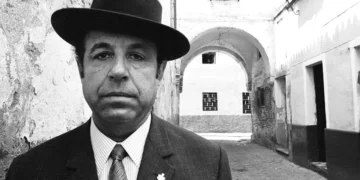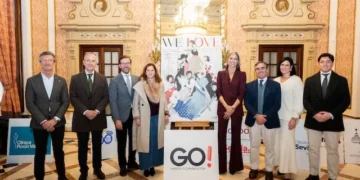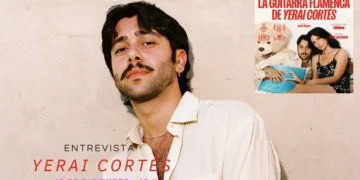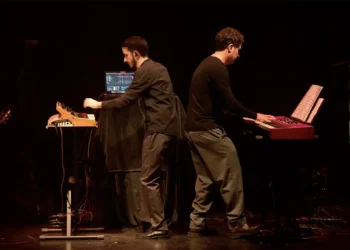|
Fifty years with the Potaje Gitano of Utrera Saturday, July |
Text & photos: Estela Zatania
A half-century…that’s a long time. Most of those
present – musicians, audience, journalists, sound technicians,
waiters, cooks and other personnel – at Utrera’s Colegio
Salesiano last Saturday night, weren’t born yet in 1957 when
the Gypsy Brotherhood of Utrera would unintentially invent a format
for flamenco shows that triggered a fashion and an entire era.

year a young singer from Puente Genil, Antonio Fernández
“Fosforito”, had recently managed a surprising triumph
at the first Córdoba flamenco contest, and in France the
first flamenco anthology in history had just been released. In Madrid,
the first tablao, Corral de la Morería, opened its doors,
and in Algeciras a ten-year-old boy called Paquito was dreaming
the guitar music destined to become the flamenco sound track that
would usher in a new century. Carmen Amaya was revealing her extraordinary
intensity to foreign audiences still struggling to distinguish flamenco
from the Mexican Hat Dance, and a singer called Antonio Mairena
was engineering his master plan to rescue traditional cante from
long years of decadence while the first tourists from abroad were
timidly beginning to test the waters of Spain’s beaches and
learning to pronounce “paella”.
The Potaje Gitano, precursor of all the summer flamenco festivals,
went on to see the founding and disappearance of many other festivals
that copied its format of long nights of cante in the open air,
bills of artists chock full of the highest level of flamenco artists
and even the concept of having the event revolve around an edible
such as snails in Lebrija (the Caracolá) or gazpacho in Morón
de la Frontera.

salaries for flamenco artists went from the level of office-worker
to that of movie star, the programs were correspondingly diminished,
and the golden anniversary of the Potaje Gitano de Utrera offered
a skimpy bill compared to editions of earlier years. Megastars of
traditional flamenco singing hardly exist any more, so we made do
with Tomasa Guerrero “Macanita” and Rafael de Utrera
to defend cante, two Diegos, Cigala and Carrasco for the light side
and Manuel de Angustias (grandson) to satisfy the permanent nostalgia
Utrera feels for one of its favorite sons, Bambino. The show was
rounded out with Morón dancer Juana Amaya and the bigger-than-life
personality to whom this edition was dedicated, the eternal lyrical
and pop singer, Raphael, Spain’s answer to Cliff Richard.
After an introduction by Manuel Peña Narvaez, one of the
festival’s original founders, Rafael with “f”,
he of Utrera, young star of flamenco singing, opened this year’s
historic edition. Not having passed through the process of oral
transmission of cante via informal gatherings that were within his
reach, Rafael took the alternative route of most of today’s
young flamenco artists, that of hard, dedicated study, and with
few exceptions his repertoire is accordingly un-Utrera. After paying
tribute to traditional cante with some tonás, he delighted
locals with the bulería song “Señorita”
made famous forty years ago by another Utrera singer, Enrique Montoya.
In this town famous for its flamenco singers, Enrique is one of
four artists whose likenesses have been immortalized in monuments
that decorate the streets (the others being Fernanda and Bernarda
de Utrera and Miguel Vargas “Bambino”).
The precursor of all the summer flamenco
festivals went on to see the founding and disappearance of many
other festivals that copied its format.

the ready-made soleá tradition of Utrera, Rafael tends to
prefer soleá apolá which he commands expertly, and
on this occasion he projected maturity and restraint, qualities
lacking in previous performances by this cantaor who also sings
“p’atrás”, for dance. Another wink for
locals was provided by the Pinini styles included in a series of
cantiñas, followed by bulerías remembering Chozas
and Camarón among others, and finishing up singing away from
the microphone which managed to irritate as many members of the
audience as those it impressed in the enormous athletic field. The
obligatory dance bit was provided by palmeros Bobote and Eléctrico
dancing in unison. Special mention for guitarist Román Vicenti.
Tomasa Guerrero “Macanita” who enjoys the admiration
of Utrera due to her devotion to the cante of Fernanda was received
with warm applause that was also for her much-admired guitarist
Diego de Morao. Looking great with her unkempt hair thrust up into
a bun and a day-glo red dress, she interpreted tientos tangos, soleá
and a bulerías set that included both traditional styles
and songs.
Diego Cigala’s fame tends to diminish in direct proportion
to the number of kilometers he is from Madrid where he is a megastar
and cult figure. The news of his astonishing success with the recording
“Lágrimas Negras” had only slight repercussion
down here in the Guadalquivir basin, and the audience gave him a
cool reception. Despite winks to Utrera duly inserted in the soleá,
catchy tangos, updated fandangos (Gloria styles sung to the compás
of Huelva) and Camarón-style bulerías with back-up
palmas and jaleo by Gregorio and Chícharo as well as Diego
de Morao on the guitar, Cigala’s showing at this historic
event made barely a ripple.
After intermission and the serving of the actual potaje or bean
stew, an excellent video showed the various celebrities in whose
honor the Potaje has been held throughout its long history, with
the images and voices of people like Manuel Torre, Antonio Mairena,
Manolo Caracol, Lola Flores and Rocío Jurado, as well as
illustrious local artists, and another video offered a brief biography
of Raphael who then received honors related to the tribute. Only
one day earlier the popular singer was awarded the Medalla de Mérito
a las Bellas Artes, official recognition for lifetime achievement.

de Angustias provided a professional, polished performance singing
classic hits of his famous uncle, Bambino, such as “Payaso”,
“Nadie se lleva nada” and “El poeta lloró”,
as well as his own single, “Cobarde”, all to the compás
of fiesta. The young man asked Raphael to join him on stage to do
a little something, just to keep the tradition, and the singer rose
to the occasion with a brief bulería dance.
Juana Amaya, the veteran dancer from Morón de la Frontera
and well-loved in Utrera, had the audience a bit confused when the
first dance was interpreted by her young daughter Nazaret Reyes.
The girl looks a great deal like her mother, and shows tremendous
potential for dance, but she’s too green to take on so much
responsibility. Things went further downhill with another soleá
interpreted by Jairo Barrull, an experienced young dancer who on
this occasion showed himself to be in full process of conversion
to the Farruco style, without having yet gotten on top of it. And
a third soleá, this time by the grand Juana Amaya herself,
intense, dangerous, flamenca and charismatic, but not quite focused,
possibly due to her daughter’s mediocre showing. The trio
of singers was noteworthy: Enrique el Extremeño, Juan José
Amador (junior) and David el Galli.
As it was coming up on 4 A.M. the country chill became insistent
enough to drive most of the audience, who had wrapped themselves
up in tablecloths and chair covers to keep warm, scurrying home,
and the quirky Diego Carrasco had to commit his devilish antics
for an athletic field with almost no “players”. Pity,
because he came to please and the group was raring to go. And thus
the golden anniversary of the Potaje Gitano de Utrera came to a
close, as Elliot would have said, “not with a bang, but a
whimper”.
More information:
Potaje 2005 – Review and images
Potaje 2003 – Review and
images
Potaje 2004– Review and
images
|
Cigala – Pack 5cds |
|
La Macanita |
|
Cultura Jonda 10. Potaje gitano de Utrera en directo |
|
Manuel de Angustias |
|
Diego Carrasco |




























